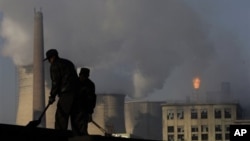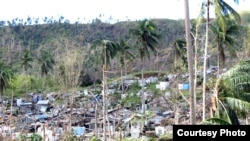Population growth threatens to strain Earth’s water and food resources. By 2050, nine billion people will be living on the planet, up from seven billion today.
The problem facing the world community is how to meet those needs while reining in the global greenhouse gases warming the earth.
Advances and losses
Progress has been made. Since world leaders met in Rio de Janeiro, Brazil, for the first Earth Summit on Sustainable Development 20 years ago, global poverty has fallen by half, per capita income has doubled and life expectancy has increased by four years.
Yet those advances have come at a very high cost to the global environment, says Andrew Steer, president of the World Resources Institute.
“We’ve had 3.3 million deaths every year over the last 20 years from pollution. We’ve been losing forests, 13 million hectares every year. That’s the size of England every single year. We’ve had a 50 percent increase in carbon dioxide and we’re now heading towards a world in which average temperatures will be four degrees Celsius above what they were historically.”
Currently 1.3 billion people lack electricity, even as a burgeoning middle class - expected to grow from 2 billion to 5 billion people by 2050 - is demanding more electric power.
Steers says 1,200 coal-fired power plants have been proposed globally in 59 countries, largely in China and India, two of the world’s biggest sources of carbon emissions. He notes renewable energy investment fell in 2012 for the first time in eight years.
But Steers is encouraged by government policies which could help reverse that trend.
“Over 100 countries now have renewable energy targets. And so what we’re looking out for this year is whether some of those new policies have bite and whether we are going to cross a threshold so that renewable energy is recognized as a truly economically viable solution.”
Renewal bubble
Ken Green, who directs the Center for Energy and Natural Resources Studies at the Fraser Institute, a free-market public policy research group based in Canada, says the market share for renewables is slim and doesn’t see them making headway any time soon.
Instead he expects what he calls the renewal bubble to burst.
“The growth in green investments that have been inflated by governments spending themselves into huge debts and deficits, and from the look of things in Europe and in the U.S., all that debt-fueled spending is going to have to come to an end sooner rather than later, based on their economies," Green says. "So I'd expect green investments to decline as more private investors realize that it’s a highly uncertain place to put your money.”
Sustainable energy by 2030
In 2012, the United Nations launched an initiative to provide universal access to energy, double energy efficiency and double the share of renewables in the global energy mix by 2030.
The World Bank is a partner in the effort. Rachel Kyte, the bank's vice president for Sustainable Development, says to meet those goals and reduce the risks of runaway climate change, nations must consider a greener energy mix that includes renewable sources and natural gas.
“There have been a series of very big natural gas finds offshore of the developing world. That becomes a huge opportunity to substitute for coal and to move to a greener energy mix in the short-to-medium term," Kyte says. "We’ve seen what gas has done for the U.S. emissions profile and for the U.S. economy and gas is changing the geopolitics of energy as a result.”
Infrastructure gap
The World Bank calculates there is a one-trillion-dollar gap in financing for infrastructure in the developing world. In spite of global economic uncertainty, Kyte says, ways must be found to cut investment risk.
She suggests, for example, tapping the $500 billion industrial nations spend for fossil fuel subsidies.
"You can take that $500 billion and repurpose it to make the kinds of investments in the green infrastructure that you need for the future and the competitive jobs that people need to have in the future."
Putting climate on political agenda
Scientists are predicting more extreme weather like the droughts, storms and wildfires that spread across the globe in 2012 as the planet heats up with man-made carbon emissions from factories, cars and buildings.
Kyte says more frequent and severe weather may be the impetus for more climate-savvy environmental policies.
“This is going to be a repeated pattern through 2013 and 2014, the intensity of these weather events. And nobody is immune. Nobody is immune. And so this will continue I think to push the [climate] agenda to the top of political priorities.”
Kyte says what needs to be done is mostly known. What is missing is the political will to act.
The problem facing the world community is how to meet those needs while reining in the global greenhouse gases warming the earth.
Advances and losses
Progress has been made. Since world leaders met in Rio de Janeiro, Brazil, for the first Earth Summit on Sustainable Development 20 years ago, global poverty has fallen by half, per capita income has doubled and life expectancy has increased by four years.
Yet those advances have come at a very high cost to the global environment, says Andrew Steer, president of the World Resources Institute.
“We’ve had 3.3 million deaths every year over the last 20 years from pollution. We’ve been losing forests, 13 million hectares every year. That’s the size of England every single year. We’ve had a 50 percent increase in carbon dioxide and we’re now heading towards a world in which average temperatures will be four degrees Celsius above what they were historically.”
Currently 1.3 billion people lack electricity, even as a burgeoning middle class - expected to grow from 2 billion to 5 billion people by 2050 - is demanding more electric power.
Steers says 1,200 coal-fired power plants have been proposed globally in 59 countries, largely in China and India, two of the world’s biggest sources of carbon emissions. He notes renewable energy investment fell in 2012 for the first time in eight years.
But Steers is encouraged by government policies which could help reverse that trend.
“Over 100 countries now have renewable energy targets. And so what we’re looking out for this year is whether some of those new policies have bite and whether we are going to cross a threshold so that renewable energy is recognized as a truly economically viable solution.”
Renewal bubble
Ken Green, who directs the Center for Energy and Natural Resources Studies at the Fraser Institute, a free-market public policy research group based in Canada, says the market share for renewables is slim and doesn’t see them making headway any time soon.
Instead he expects what he calls the renewal bubble to burst.
“The growth in green investments that have been inflated by governments spending themselves into huge debts and deficits, and from the look of things in Europe and in the U.S., all that debt-fueled spending is going to have to come to an end sooner rather than later, based on their economies," Green says. "So I'd expect green investments to decline as more private investors realize that it’s a highly uncertain place to put your money.”
Sustainable energy by 2030
In 2012, the United Nations launched an initiative to provide universal access to energy, double energy efficiency and double the share of renewables in the global energy mix by 2030.
The World Bank is a partner in the effort. Rachel Kyte, the bank's vice president for Sustainable Development, says to meet those goals and reduce the risks of runaway climate change, nations must consider a greener energy mix that includes renewable sources and natural gas.
“There have been a series of very big natural gas finds offshore of the developing world. That becomes a huge opportunity to substitute for coal and to move to a greener energy mix in the short-to-medium term," Kyte says. "We’ve seen what gas has done for the U.S. emissions profile and for the U.S. economy and gas is changing the geopolitics of energy as a result.”
Infrastructure gap
The World Bank calculates there is a one-trillion-dollar gap in financing for infrastructure in the developing world. In spite of global economic uncertainty, Kyte says, ways must be found to cut investment risk.
She suggests, for example, tapping the $500 billion industrial nations spend for fossil fuel subsidies.
"You can take that $500 billion and repurpose it to make the kinds of investments in the green infrastructure that you need for the future and the competitive jobs that people need to have in the future."
Putting climate on political agenda
Scientists are predicting more extreme weather like the droughts, storms and wildfires that spread across the globe in 2012 as the planet heats up with man-made carbon emissions from factories, cars and buildings.
Kyte says more frequent and severe weather may be the impetus for more climate-savvy environmental policies.
“This is going to be a repeated pattern through 2013 and 2014, the intensity of these weather events. And nobody is immune. Nobody is immune. And so this will continue I think to push the [climate] agenda to the top of political priorities.”
Kyte says what needs to be done is mostly known. What is missing is the political will to act.












